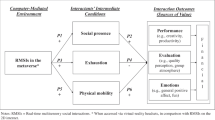Abstract
Various studies have demonstrated that the mode by which people communicate affects the content of their messages. The present study examines the ways in which one aspect of language use, namely figurative language, differs as a function of mode of communication. Subjects worked together in pairs to build a small household appliance, with an “expert” directing a novice in the construction. Subjects communicated in one of four modes: full copresence, separated by a screen, through an intercom system, or through e-mail. Differences between modes were found on a number of measures of figurative language types, including what the author has described as “interrogative analogies”. These differences are discussed in terms of costs, constraints, and affordances associated with different media, and the role figurative language plays in communication.
Similar content being viewed by others
References
Barlow J.M., Kerlin J.R. Pollio H.R. (1971). Training manual for identifying figurative language (Technical Report #1). Knoxville: Metaphor research group, University of Tennessee
M.A. Boerger T.B. Henley (1999) ArticleTitleThe use of analogy in giving instructions The Psychological Record. 49 193–209
A. Chapanis R.B. Ochsman R.N. Parrish G.D. Weeks (1972) ArticleTitleStudies in interactive communication: I. The effects of four communication modes on the behavior of teams during cooperative problem-solving. Human Factors. 14 487–509
A. Chapanis R.N. Parrish R.B. Ochsman G.D. Weeks (1977) ArticleTitleStudies in interactive communication: II The effects of four communication modes on the linguistic performance of teams during cooperative problem-solving. Human Factors. 19 101–126
H.H. Clark S. E. Brennan (1991) Grounding in communication. L.B. Resnick J. M. Levine S. D. Teasley (Eds) Perspectives on socially shared cognition American Psychological Association Washington, D. C 127–149
H.H. Clark D. Wilkes-Gibbs (1986) ArticleTitleReferring as a collaborative process Cognition 22 1–39 Occurrence Handle3709088
P.R. Cohen (1984) ArticleTitleThe pragmatics of referring and the modality of communication Computational Linguistics 10 97–146
M.A. Columbus P.J. Boerger (2002) ArticleTitleDefining popular iconic metaphor Psychological Reports 90 579–582 Occurrence Handle12061600
S.R. Fussell R.M. Krauss (1989) ArticleTitleThe effects of intended audience on message production and comprehension: Reference in a common ground framework Journal of Experimental Social Psychology 25 203–219
S. Glucksberg (1989) ArticleTitleMetaphors in conversation: How are they understood? Why are they used? Metaphor and Symbolic Activity 4 125–143
M.G. Johnson R.G. Malgady (1979) ArticleTitleSome cognitive aspects of figurative language: association and metaphor Journal of Psycholinguistic Research 8 IssueID3 249–265
S. Kiesler J. Siegel T.W. McGuire (1984) ArticleTitleSocial psychological aspects of computer-mediated communication American Psychologist. 39 IssueID10 1123–1134
R.M. Krauss S.R. Fussell (1991) Constructing shared communicative environments. L. L. Resnick J. Levine S. Teasley (Eds) Perspectives on socially shared cognition American Psychological Association Washington, D. C 172–202
R.M. Krauss S. Glucksberg (1977) ArticleTitleSocial and nonsocial speech Scientific American. 236 100–105 Occurrence Handle194309
R.M. Krauss S. Weinheimer (1964) ArticleTitleChanges in the length of reference phrases as a function of social interaction; A preliminary study Psychonomic Science. 1 113–114
G. Lakoff M. Johnson (1980) Metaphors we live by University of Chicago Press Chicago
R.B. Ochsman A. Chapanis (1974) ArticleTitleThe effects of 10 communication modes on the behavior of teams during cooperative problem-solving International Journal of Man-Machine Studies. 6 579–619
A. Ortony (1975) ArticleTitleWhy metaphors are necessary and not just nice Educational Theory 25 45–53
H.R. Pollio J.M. Barlow H.J. Fine M.R. Pollio (1977) Psychology and the poetics of growth: Figurative language in psychology, psychotherapy and education Lawrence Erlbaum Associates, Inc Hillsdale, N. J
H.R. Pollio M.K Smith. M.R. Pollio (1990) ArticleTitleFigurative language and cognitive psychology Language and Cognitive Processes. 5 141–167
F.C. Stoll D.G. Hoecker G.P. Krueger A. Chapanis (1976) ArticleTitleThe effects of four communication modes on the structure of language used during cooperative problem solving The Journal of Psychology. 94 13–26
R.R. Verbrugge (1985) Language and event perception: Steps toward a synthesis. W. H. Warren R. Shaw (Eds) Persistence and Change Lawrence Erlbaum Associates Hillsdale, N. J 157–194
Author information
Authors and Affiliations
Corresponding author
Rights and permissions
About this article
Cite this article
Boerger, M.A. Variations in Figurative Language Use as a Function of Mode of Communication. J Psycholinguist Res 34, 31–49 (2005). https://doi.org/10.1007/s10936-005-3630-9
Issue Date:
DOI: https://doi.org/10.1007/s10936-005-3630-9




